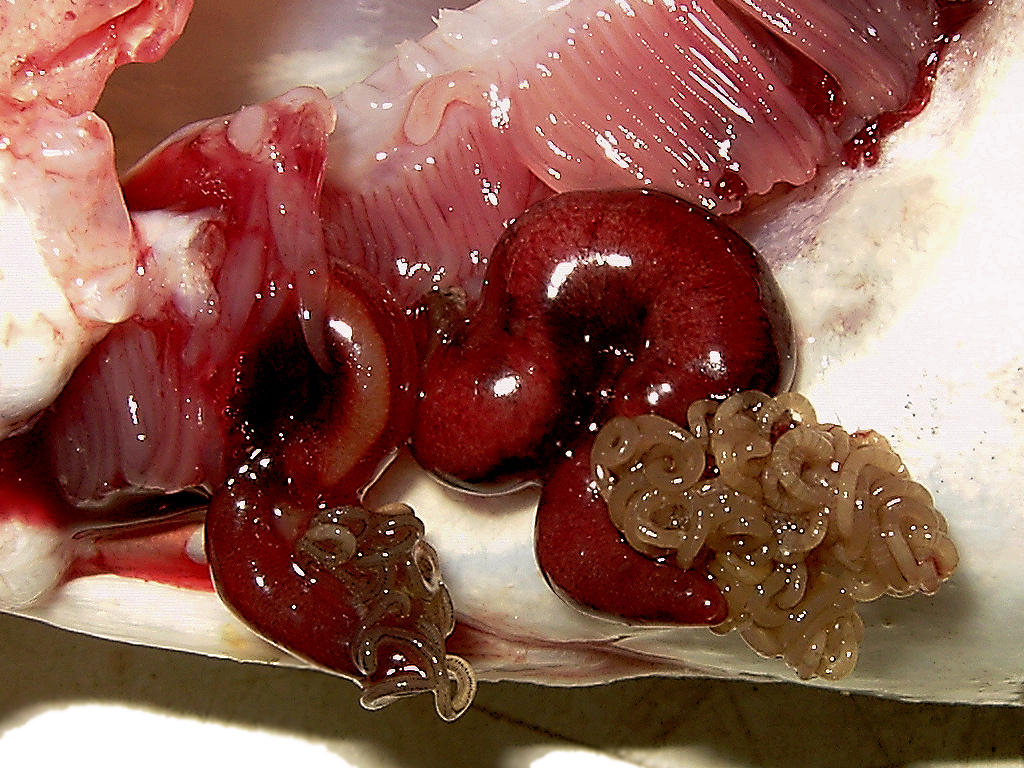|
List Of Diseases And Parasites In Cod
Cod and related species in the family Gadidae are susceptible to a variety of diseases and parasites. ''Laenaeocera branchialis'' ''Lernaeocera branchialis'', the "cod worm", is a copepod that infects gadoids. The first host used by cod worm is a flatfish or lumpsucker, which it captures with grasping hooks at the front of its body. It penetrates the lumpsucker with a thin filament, which it uses to suck the host's blood. The nourished cod worm then mates with another one on the lumpsucker.Matthews B (1998''An Introduction to Parasitology''Page 73–74. Cambridge University Press. . The female worm, with her now-fertilized eggs, then finds a cod, or a cod-like fish, such as a haddock or whiting. There, the worm clings to the gills while it metamorphoses into a plump, sinusoidal, worm-like body, with a coiled mass of egg strings at the rear. The front part of the worm's body penetrates the body of the cod until it enters the rear bulb of the host's heart. There, firmly rooted in ... [...More Info...] [...Related Items...] OR: [Wikipedia] [Google] [Baidu] |
Lernaeocera Branchialis
''Lernaeocera branchialis'', sometimes called cod worm, is a parasite of marine fish, found mainly in the North Atlantic. It is a marine copepod which starts life as a small pelagic crustacean larva. It is among the largest of copepods, ranging in size from when it matures as a copepodid larva to more than as a sessile adult. ''Lernaeocera branchialis'' is ectoparasitic, which means it is a parasite that lives primarily on the surface of its hosts. It has many life stages, some of which are motile and some of which are sessile. It goes through two parasitic stages, one where it parasitizes as a secondary host a flounder or lumpsucker, and another stage where it parasitizes as a primary host a cod or other fishes of the cod family (gadoids). It is a pathogen that negatively impacts the commercial fishing and mariculture of cod-like fish. Life stages The life-cycle of a cod worm involves a complex progression of life stages, including two successive hosts. It comprises "two fre ... [...More Info...] [...Related Items...] OR: [Wikipedia] [Google] [Baidu] |
Diclidophora Merlangi
''Diclidophora'' is a genus of flatworms belonging to the family Diclidophoridae. The genus has almost cosmopolitan distribution. Species: *'' Diclidophora caudospina'' *'' Diclidophora denticulata'' *'' Diclidophora embiotocae'' *'' Diclidophora esmarkii'' *'' Diclidophora esmarkii'' *'' Diclidophora indica'' *'' Diclidophora luscae'' *'' Diclidophora maccallumi'' *'' Diclidophora merlangi'' *''Diclidophora micromesisti'' *''Diclidophora minor'' *''Diclidophora minuti'' *''Diclidophora morrhuae'' *''Diclidophora paddiforma'' *''Diclidophora pagelli'' *''Diclidophora palmata'' *''Diclidophora phycidis'' *''Diclidophora pollachii'' *''Diclidophora srivastavai ''Diclidophora'' is a genus of flatworms belonging to the family Diclidophoridae. The genus has almost cosmopolitan distribution In biogeography, cosmopolitan distribution is the term for the range of a taxon that extends across all or most ...'' References {{Taxonbar, from=Q14372542 Diclidoph ... [...More Info...] [...Related Items...] OR: [Wikipedia] [Google] [Baidu] |
Rhipidocotyle
Bucephalidae is a family of trematodes that parasitize fish. They lack suckers, having instead a muscular organ called a "rhynchus" at the front end which they use to attach to their hosts. The characteristics of the rhynchus are used to help define the genera of the family.Hassanine, R. M. E. (2002)On three digenean trematodes (Family Bucephalidae) from marine teleost fishes with new record from the Red Sea.''Egyptian Journal of Aquatic Biology and Fisheries'', 6(3), 1–16. It is one of the largest digenean families, with 25 genera containing hundreds of described species.Muñoz, G. & Bott, N. J. (2011)A new species of ''Prosorhynchoides'' (Trematoda, Bucephalidae) from the intertidal rocky zone of central Chile. ''Acta Parasitologica'', 56(2), 140–146. Bucephalids are cosmopolitan, having been recorded all over the world. They are parasites of fish from freshwater, marine, and brackish water habitat types. The name ''Bucephalus'', meaning "ox head", was originally applied to ... [...More Info...] [...Related Items...] OR: [Wikipedia] [Google] [Baidu] |
Prosorhynchus Crucibulum
Bucephalidae is a family of trematodes that parasitize fish. They lack suckers, having instead a muscular organ called a "rhynchus" at the front end which they use to attach to their hosts. The characteristics of the rhynchus are used to help define the genera of the family.Hassanine, R. M. E. (2002)On three digenean trematodes (Family Bucephalidae) from marine teleost fishes with new record from the Red Sea.''Egyptian Journal of Aquatic Biology and Fisheries'', 6(3), 1–16. It is one of the largest digenean families, with 25 genera containing hundreds of described species.Muñoz, G. & Bott, N. J. (2011)A new species of ''Prosorhynchoides'' (Trematoda, Bucephalidae) from the intertidal rocky zone of central Chile. ''Acta Parasitologica'', 56(2), 140–146. Bucephalids are cosmopolitan, having been recorded all over the world. They are parasites of fish from freshwater, marine, and brackish water habitat types. The name ''Bucephalus'', meaning "ox head", was originally applied to ... [...More Info...] [...Related Items...] OR: [Wikipedia] [Google] [Baidu] |

